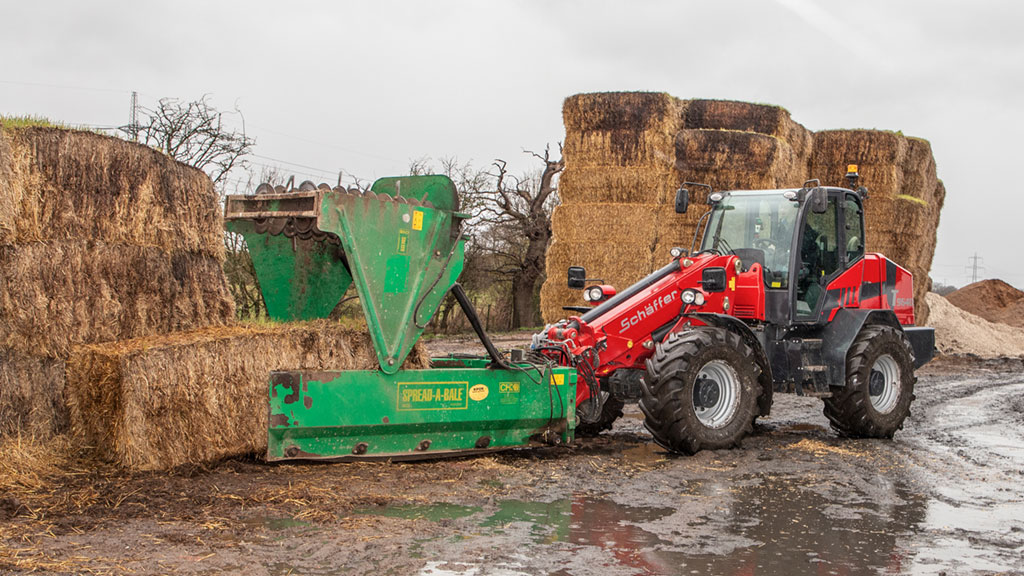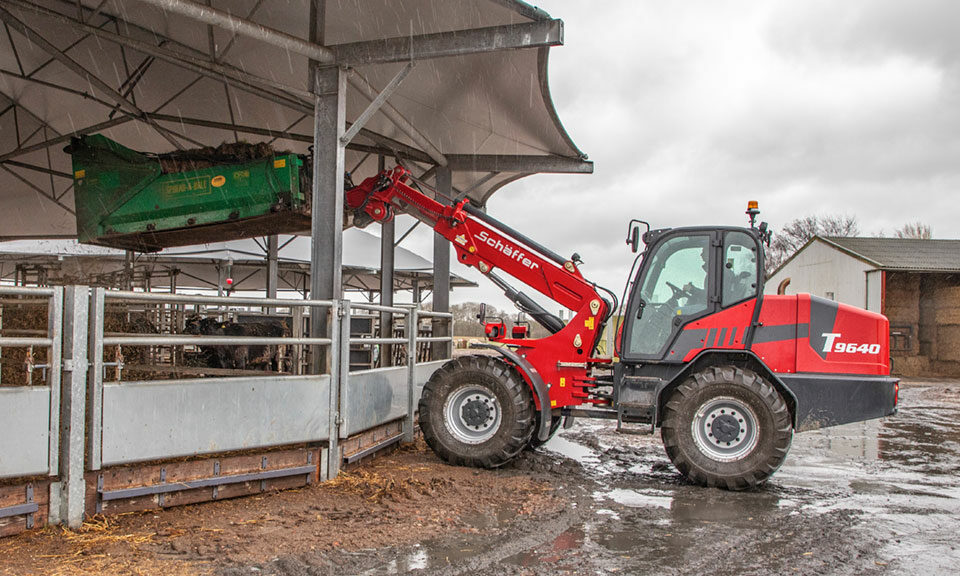9640 T: strong and robust
In search of better visibility from the cab, one Yorkshire farm has moved away from a rigid chassis telehandler to a pivot steer machine, opting for a German-built Schäffer model over more traditional choices.
— By Geoff Ashcroft, Freelance Technical Journalist from Carterton, Oxfordshire (UK), published in “Farmers Guardian”, March 2020 —
With 400-head of beef cattle to feed on a daily basis, plus bedding and mucking out, Mark Green needs reliability, productivity and performance from all his machinery. But the machine he relies on most, is the farm’s Schäffer 9640 T pivot-steer telescopic handler. It is one of two materials handlers used at the 120ha Laund House Farm, Wigginton, York – the other is a compact Kramer Allrad 750T, used in smaller spaces.
“We’re now on our third Schäffer handler,” explains Mark Green. “We’ve run them for around 10 years, since replacing an old John Deere 3200 rigid chassis machine. Our primary objective was to improve visibility when working in and around livestock and buildings, and having a high seating position with a pivot-steer handler was the way forward for us.”
The farm’s first Schäffer was a 9330 T, followed several years later by a 9630 T both supplied by J Wood & Son from Kirby Moorside. The current handler arrived in July 2019, and was purchased as an ex-demo model from local dealer Brockhills at Thirsk. “We really wanted a new model, but the uncertainty of supply over Brexit meant we were looking at a potential nine month wait,” says Mark. “So this one arrived with 500 hours on the clock, and it has now done over 1,300 hours. We’ll cover around 1,500-1,700 hours each year with the Schäffer.”

However, buying a third Schäffer in succession was by no means a done deal. The farm simultaneously tried the 9640 T against a JCB TM320, side-by-side, to make sure it was getting the best machine for the farm’s requirements. “It was a very useful comparison, and interesting to see working against the market leader,” he recalls. “While there was little to separate them on price, we noticed quite a difference in build quality, and our impression was that Schäffer had more strength and robustness in all the right areas.”
“You only need to look at wheel nuts – five on the JCB and 10 on the Schäffer; the JCB’s headstock looked thinner and weaker too, where the Schäffer looked better able to withstand harder work,” he adds. And son Edward agrees. “We needed to make a comparison to confirm that we’re still buying the right machine for our needs,” says Edward Green. “And the Schäffer continues to improve – this latest model also has a much heavier centre-pivot joint than the last one. Okay, it’s a beefier machine, but all those little things inspire confidence that product developments are taking place.”
Both agreed that while the JCB offered the larger cab, the Schäffer’s relocated air conditioning controls – from the lower part of the front windscreen to the right-hand side of the cab – was an improvement they wanted. LED lights, a leather seat and leather-trimmed steering wheel added to operator comfort and convenience for the German-built machine. “The JCB did have a neat additional mirror on the front right-hand mudguard for road work,” says Edward. “It was an idea that we adopted, but rather than stop at one, we fitted a pair on the 9640 T to improve visibility down both sides of the chassis, to the sides of the rear wheels.”
“This adds a lot to the overall scope of visibility from the cab. And with a sloping engine canopy at the rear, you’re not blind-sided like a rigid machine,” he adds. “Overall, it’s quite a good package.” He says that JCB’s integration of the chassis oscillation point through the centre-pivot created a feeling that neither felt they could get used to. “With all these little differences, we chose to stick with red,” says Edward. “The biggest trade-off is probably the awkward handbrake position, which requires reaching down between the right-hand armrest and the console to operate. It could be better.”
Schäffer’s 9640 T offers a 4.2 tonne lift capacity, a straight tipping load of 5.3 tonnes, a maximum forward reach of 2.75m, and a maximum lift height of 5.4m – helped by an operating weight that can be ballasted from 8.4 to 9.7 tonnes. Power comes from a 136hp Deutz four-cylinder diesel engine, driving all four wheels through a hydrostatic transmission – or optional dual clutch transmission which allows a road speed of 40kph.
“The demo model had a hydrostatic transmission, which gave a good level of controllability,” says Edward. “And it’s proving to be very light on diesel consumption, particularly with the Eco mode enabled. When we put the Schäffer and JCB head-to-head, the 9640 T was using around five litres less fuel per hour. And that’s a big saving over a three-year, 5,000-hour ownership period.”
“While it doesn’t have the biggest of fuel tanks, the Schäffer will easily do a day’s work without needing a top-up,” he adds. “And with steel fabricated diesel and hydraulic tanks behind the rear wheels, both add to the counterweight effect.”
At Laund House Farm, the 9640 T handles the lion’s share of materials handling duties. Given its 1,500-hour minimum annual workload, the handler will make the most of its three-year/3,000-hour warranty and then be replaced, keeping a frontline handler in tip-top condition.
Though there are times when the Greens need access into tighter spaces. It is why the farm also runs an older Kramer Allrad 750T, which is used in the two round-house livestock buildings where space is at a premium. “The circular buildings are great for cattle and ventilation, but less-so for larger machinery,” he says. “And should there ever be a problem with the Schäffer, then we still have a loader that can fill our 28-cube feeder wagon.”
Attachment choices are historically pin and cone-derived for the Green family. In addition to a dedicated grain bucket, there is also a feed bucket, bucket-brush, muck grab, pallet forks, bale spike and Spread-a-Bale attachment – the latter can be telescoped over feed barriers to reach into buildings when bedding cattle.
“With a generous lift capacity and a telescopic boom, the 9640 T handles the Spread-a-Bale with ease,” he adds. But it’s not all livestock work at Laund House Farm. While 15 hectares provides grass crops for hay, the remaining 105 hectares plays host to combinable crops, giving rise to a ready source of straw, albeit baled by a local contractor.
Drill filling, fertiliser spreading and lorry loading are also tasks that the 9640 T takes in its stride. “We don’t pull trailers with the Schäffer, but for everything else, it offers great strength and performance, particularly for bale stacking and loading trailers,” says Mark. “Our experience has proved that while there’s a good choice of pivot steer machines now available, we’ve been pleasantly surprised by residual values from this lesser-known brand.”
“Add to that some great back-up and servicing from our local dealer, and we’ve got little reason to move away from this robust, well-built handler. It has become a machine that we rely on.”
Click here to download the PDF version of this success story.


